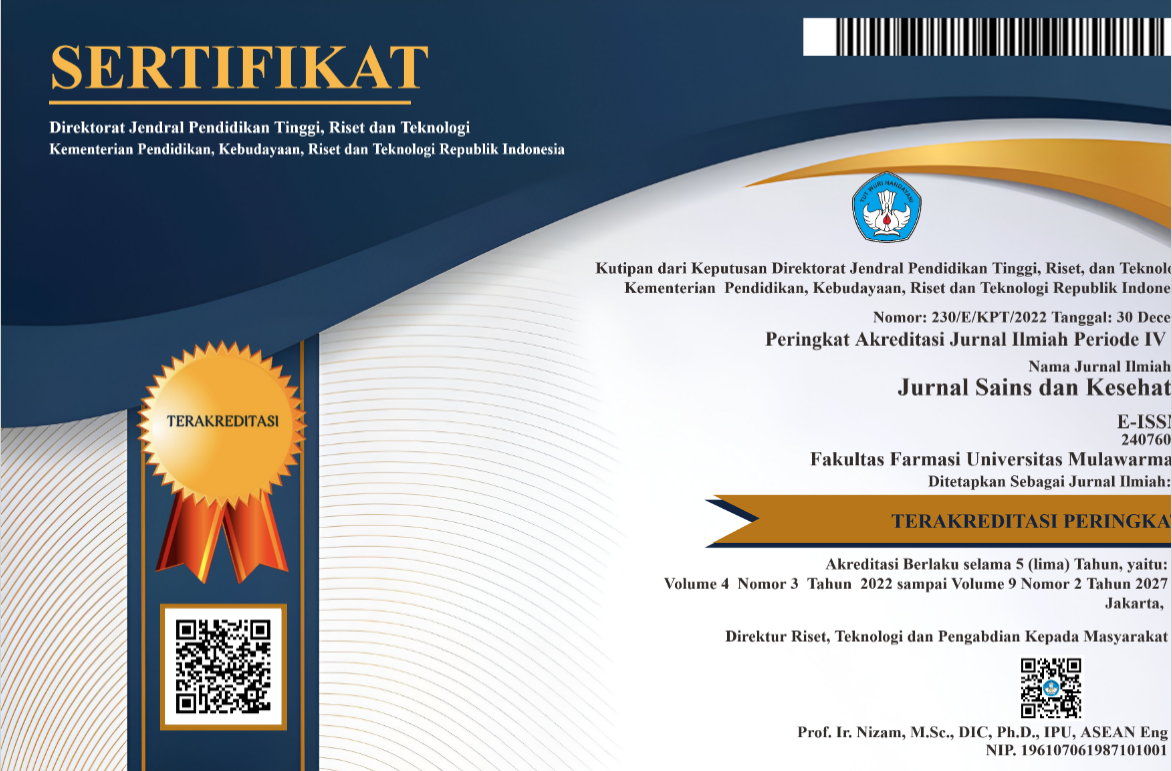Evaluation of Remdesivir in Liver Functions Covid-19 Patients At Bhayangkara H.S Samsoeri Mertojoso Hospital Surabaya
Keywords:
remdesivir, covid-19, hepatotoxicityAbstract
References
K. Renu, P. L. Prasanna, and A. V. Gopalakrishnan, “Coronaviruses pathogenesis, comorbidities and multi-organ damage – A review,” Life Sciences, no. January, p. 117839, 2020.
H. Chu et al., “Comparative tropism, replication kinetics, and cell damage profiling of SARS-CoV-2 and SARS-CoV with implications for clinical manifestations, transmissibility, and laboratory studies of COVID-19: an observational study,” Lancet Microbe, no. January, pp. 19–21, 2020.
Z. Wang, W. Qiang, and H. Ke, “A Handbook of 2019-nCoV Pneumonia Control and Prevention,” Hubei Science and technology press, pp. 1–108, 2020.
C. Ceraolo and F. M. Giorgi, “Genomic Variance of the 2019-nCoV Coronavirus,” Journal of Medical Virology, vol. 92, no. 5. pp. 522–528, 2020. doi: 10.1002/jmv.25700.
M. Hoffmann, H. Kleine-Weber, N. Krüger, M. Müller, C. Drosten, and S. Pöhlmann, “The Novel Coronavirus 2019 (2019-nCoV) Uses the SARS-coronavirus Receptor ACE2 and the Cellular Protease TMPRSS2 for Entry into Target Cells,” bioRxiv, 2020, doi: 10.1101/2020.01.31.929042.
A. D. Nardo, M. S. May, E. D. Dixon, S. F. Lax, and M. Trauner, “Pathophysiological mechanisms of liver injury in COVID-19,” no. November, pp. 1–13, 2020, doi: 10.1111/liv.14730.
K. Yang, B. A. Howell, J. Y. Feng, D. Babusis, T. Cihlar, and S. Q. Siler, “Assessment of the Mechanism for Remdesivir-Associated Clinical ALT Elevations Using DILIsym Quantitative Systems Toxicology Modeling,” vol. 13, p. 2020, 2020.
E. Burhan et al., Pedoman tatalaksana COVID-19 Edisi 3 Desember 2020. 2020. [Online]. Available: https://www.papdi.or.id/download/983-pedoman-tatalaksana-covid-19-edisi-3-desember-2020
T. Haitao et al., “COVID-19 and Sex Differences: Mechanisms and Biomarkers,” MAYO CLINIC PROCEEDINGS, vol. 95, no. 1, pp. 2189–2203, 2020, [Online]. Available: http://www.akrabjuara.com/index.php/akrabjuara/article/view/919
M. J. Nasiri et al., “COVID-19 Clinical Characteristics, and Sex-Specific Risk of Mortality: Systematic Review and Meta-Analysis,” Frontiers in Medicine, vol. 7, no. July, pp. 1–10, 2020, doi: 10.3389/fmed.2020.00459.
PDPI, PERKI, PERDATIN, IDAI, and PAPDI, “Revisi Protokol Tatalaksana COVID?19,” 2021.
Yao Na et al., “Clinical characteristics and influencing factors of patients with novel coronavirus pneumonia combined with liver injury in Shaanxi region,” Chinese Journal of Hepatology, vol. 28(03), pp. 234–239, 2020, doi: doi: 10.3760/cma.j.cn501113-20200226-00070.
Y. J. Wong et al., “A systematic review and meta-analysis of the COVID-19 associated liver injury,” Annals of Hepatology, vol. 19, no. 6, pp. 627–634, 2020, doi: 10.1016/j.aohep.2020.08.064.
C. A. Philips et al., “Critically Ill COVID-19 Patient with Chronic Liver Disease - Insights into a Comprehensive Liver Intensive Care,” Journal of Clinical and Translational Hepatology, vol. 000, no. 000, pp. 000–000, 2021, doi: 10.14218/jcth.2020.00110.
J. G. Stoffolano, “Hematological and Biochemical Factors Predicting SARS Fatality in Taiwan,” Elsevier & Formosan Medical Association, pp. 439–450, 2006.
A. Delgado et al., “Characterisation of drug-induced liver injury in patients with covid-19 detected by a proactive pharmacovigilance program from laboratory signals,” Journal of Clinical Medicine, vol. 10, no. 19, 2021, doi: 10.3390/jcm10194432.
EMA, “Summary on Compassionate Use Remdesivir Gilead International Nonproprietary Name: Remdesivir,” European Medicines Agency, vol. 31, no. April, p. 41, 2020, [Online]. Available: https://www.ema.europa.eu/en/documents/other/summary-compassionate-use-remdesivir-gilead_en.pdf
A. Rezagholizadeh, S. Khiali, P. Sarbakhsh, and T. Entezari-Maleki, “Remdesivir for treatment of COVID-19; an updated systematic review and meta-analysis,” European Journal of Pharmacology, no. January, p. 173926, 2021.
J. H. Beigel et al., “Remdesivir for the Treatment of Covid-19 — Final Report,” New England Journal of Medicine, vol. 383, no. 19, pp. 1813–1826, 2020, doi: 10.1056/nejmoa2007764.
J. Grein et al., “Compassionate Use of Remdesivir for Patients with Severe Covid-19,” New England Journal of Medicine, vol. 382, no. 24, pp. 2327–2336, 2020, doi: 10.1056/nejmoa2007016
Downloads
Published
Issue
Section
Deprecated: json_decode(): Passing null to parameter #1 ($json) of type string is deprecated in /home/jskff/public_html/plugins/generic/citations/CitationsPlugin.php on line 68
How to Cite
Most read articles by the same author(s)
- Risa Septinia, Didik Hasmono, Covid-19 and Its Vaccine Development: A Narrative Review , Jurnal Sains dan Kesehatan: Vol. 3 No. 6 (2021): J. Sains Kes.
Similar Articles
- Taureni Hayati, Mirna Albertina Wijaja, Sri Murtiyani Kusumastuti, Profil Hematologi Pasien Covid-19 Berdasarkan Beratnya Kasus , Jurnal Sains dan Kesehatan: Vol. 4 No. 3 (2022): J. Sains Kes.
- Ira Purbosari, Muhammad Wahyono, Profil Pengetahuan dan Keyakinan Vaksinasi Covid-19 Aztrazeneca dan Sinovac sebagai Upaya Pencegahan Covid-19 pada Warga Surabaya , Jurnal Sains dan Kesehatan: Vol. 4 No. 3 (2022): J. Sains Kes.
- Dwi Fitrah Wahyuni, An Nisaa Nurzak, Arifuddin Yunus, Nabilah Baharuddin, Sitti Nur Intang, Pola Pengobatan Covid-19 pada Pasien Komorbid di RSUD dr. La Palaloi , Jurnal Sains dan Kesehatan: Vol. 4 No. 5 (2022): J. Sains Kes.
- Aulia Seftiya, Khemasili Kosala, Epidemiologi Karakteristik Pasien Covid-19 di Kalimantan Utara , Jurnal Sains dan Kesehatan: Vol. 3 No. 5 (2021): J. Sains Kes.
- Okta Muthia Sari, Aditya Maulana Perdana Putra, Yusrinie Wasiaturrahmah, Nahdiya Rahmah, Analisis Faktor yang Berhubungan dengan Potensi Interaksi Obat Pasien Covid-19 di Salah Satu Rumah Sakit Kalimantan Selatan , Jurnal Sains dan Kesehatan: Vol. 5 No. 5 (2023): J. Sains Kes.
- Semuel Piter Irab, Rosmin M. Tingginehe, Yacob Ruru, Keterbatasan Pangan Balita Perkotaan dan Pedesaan Provinsi Papua Indonesia pada Masa Pandemi COVID-19 , Jurnal Sains dan Kesehatan: Vol. 4 No. 1 (2022): J. Sains Kes.
- Welin Devsi Apriani, Sinta Ratna Dewi , Hubungan antara Tingkat Pengetahuan dengan Kesediaan Vaksinasi Covid-19 pada Masyarakat di Kabupaten Kutai Kartanegara , Jurnal Sains dan Kesehatan: Vol. 4 No. 4 (2022): J. Sains Kes.
- Kevin Sanjaya, Swandari Paramita, Muhammad Rizqan Khalidi, Epidemiologi Karakteristik Pasien COVID-19 di Kutai Kartanegara pada Bulan Juli-Desember 2020 , Jurnal Sains dan Kesehatan: Vol. 3 No. 6 (2021): J. Sains Kes.
- Mukhlidah Hanun Siregar, Mustika Arumbinang, Junengsih Junengsih, Eksplorasi Obesitas Sebagai Faktor Komorbid Covid-19: A Systematic Review , Jurnal Sains dan Kesehatan: Vol. 4 No. 5 (2022): J. Sains Kes.
- Agus Susanto, Ratih Sakti Prastiwi, Kristy Suwito, Ulfatul Latifah, Hubungan Sosio-Demografi dengan Tingkat Pengetahuan Masyarakat Kota Tegal tentang COVID-19 , Jurnal Sains dan Kesehatan: Vol. 3 No. 6 (2021): J. Sains Kes.
You may also start an advanced similarity search for this article.




